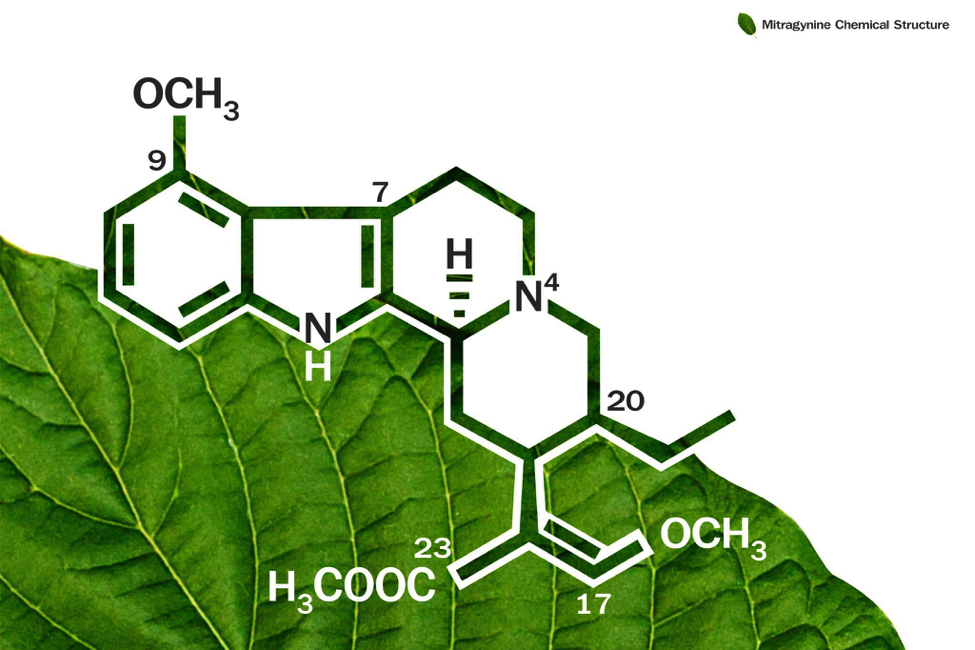Kratom has become more and more commonly studied in recent years. Not only does it have the potential to be a natural stimulant like Coffee, but it also has the potential to be used to create new treatments for pain, addiction, and other serious issues.
Often, researchers looking into kratom as a potential pain reliever are looking more specifically into one compound found in kratom. 7-hydroxymitragynine is a natural product derived from the kratom leaf, and this compound is one of the most interesting to those studying kratom for its potential effects.
What is so special about 7-hydroxymitragynine, often referred to as 7-OH, and why are scientists excited about the possibilities it brings to the table?
Today, let’s learn more about this alkaloid and what we know about it.
7-OH: The Basics
Let’s start with covering the basics of 7-hydroxymitragynine.
7-OH is an alkaloid that is derived from the plant Mitragyna speciosa, a.k.a. the kratom plant. 7-OH is an oxidized derivative of mitragynine, which is present in kratom leaves. This compound was first discovered in 1994, and it has been continually studied since that time.
7-OH is found in limited quantities in the kratom plant as it is a minor alkaloid, but it is still very interesting to scientists because more 7-OH is created through the metabolic process once kratom is in the body.
What Is Kratom?
Understanding what 7-OH is and where it comes from relies on also knowing what the kratom plant is.
Kratom is a plant found native in certain regions of Southeast Asia. Traditionally, the leaves of the kratom plant have been used in teas and chews as an analgesic, stimulant, and even as a way to help prevent and treat opioid addiction.
In recent years, more and more people in the United States have been using kratom. The reasons for them using kratom vary, but many believe it has the ability to help with pain, anxiety, and a number of other issues they face.
Because it is being used more commonly, there are concerns about how well we actually understand this plant, and studies have been ongoing to better understand how it works in the body.
What Is Mitragynine?
Mitragynine is the primary active alkaloid found in kratom leaves and kratom products. In animal studies, mitragynine has shown opioid agonist activity as well as analgesic activity.
The specifics of how mitragynine works in the body, however, are still being understood. There have been studies which show that there are many therapeutic effects may occur, and that mitragynine may help to prevent opioid addiction as well.
Because mitragynine still functions with the opioid receptor system in the body, however, more studies are still needed to understand exactly what is happening.

7-OH As An Opioid Analgesic
Opioid analgesics are the most commonly prescribed class of medications, but they are also a growing concern in the US. Many of these analgesics are subject to addiction and misuse by patients, and there is a public health crisis surrounding opioid-related deaths.
As a response to this crisis, many people are looking for other ways to treat their pain naturally or to curb their dependence on opioids. Some have tried taking kratom as a way to do both of those things, and this application is being studied in more detail.
Metabolism-Depend Reactions
Recent studies have shown that mitragynine, once in the body, undergoes a metabolism-dependent process to create any of the effects which it is known for. 7-OH is the primary metabolite for mitragynine, which means that 7-OH is necessary for the most efficient effects of mitragynine to occur.
In fact, studies have shown that the amount of 7-OH found in the body lines up with the disappearance of mitragynine as the body metabolizes it; there is likely a direct correlation.
7-OH has a major role to play in the potential of using kratom and mitragynine as a pharmacological treatment, and it is being studied in more detail as a linking factor to better understand the potential positive effects of kratom.
Interspecies Differences Matter
Much of the above information about 7-OH and how it works has been found in various types of studies done on mice and similar animals. At this time, there have not been a substantial number of pharmaceutical studies on how mitragynine and 7-OH function in the human body.
Since 7-OH and mitragynine depend on the metabolic system to process and work in the body, however, it is expected for there to potentially be a large number of interspecies differences. In time, studies will need to be done on humans to better understand those differences and how they could change the outcome of how 7-OH and mitragynine affect the body.
How 7-OH May Develop
Why does 7-OH matter, and why are scientists so interested in finding out more about exactly how it interacts with the body?
Ultimately, most of the scientists studying kratom and 7-OH are hoping to discover if it could be used to develop less addictive forms of pain medication that could replace opioids that may be more dangerous in their effects.
Early studies suggest that 7-OH has a higher affinity for bonding with mu-receptors in the body while also having higher potency. Essentially, it is possible that it could cause similar positive effects while having fewer side effects.
Until science is able to get a better understanding of kratom at that level, however, we won’t know for sure.
The Future Of Kratom
The most important thing to take away from understanding more about 7-OH, however, is that there are still so many possibilities! While the natural uses of kratom are already very impressive, it is important for the health of the industry at large for things to be better understood on a base scientific level.
Not only will those studies help to solidify the safety and health of the kratom industry, but they will also help to allow scientists to create new medications that utilize the power of kratom to better treat opioid addiction, pain, and other prevalent issues facing people around the world today.


